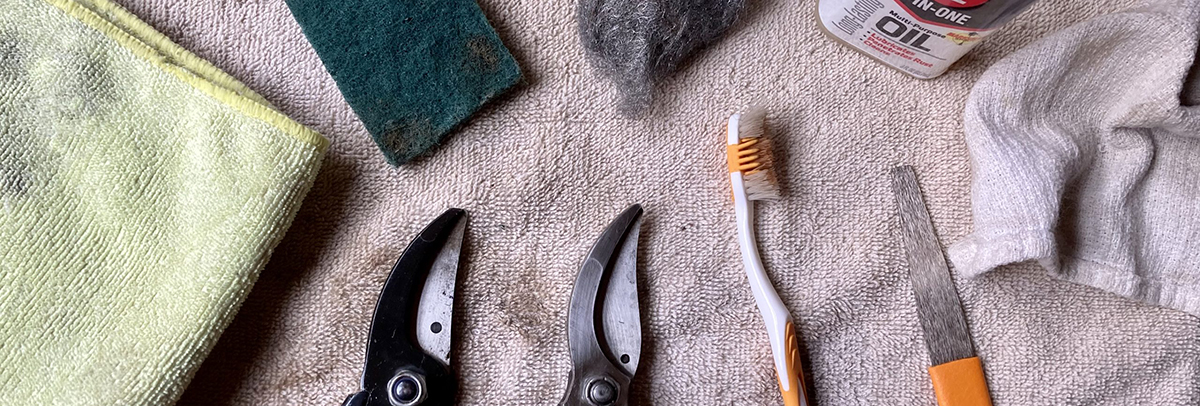There are a variety of tools that can be used for pruning, from hand pruners to chainsaws. We’ll share which tools Heartland Tree Alliance uses while pruning young trees in Kansas City.
A word to the wise: Pruning is intentional wounding for a specific purpose. Improper pruning can severely damage, stress or even kill trees. Learn how to prune before you do.
Tips:
- Size of the limb to be cut determines the tool to be used. Look at your tree(s) and think about what cuts you’ll make. Chances are, unless you’re starting a pruning business, you won’t need every tool in the toolbox.
- Purchase tools that allow you to stay on the ground, like pole pruners.
- Keep tools sharp. We sharpen pruners but we just purchase new blades for saws. (We like this cleaning and sharpening how-to video.)
- Keep pruners and loppers oiled and free from rust.
- Sanitize tools between trees with at least 70% denatured alcohol. You don’t want to spread diseases.
Caution: Realize when it’s time to contact an arborist. Never cut near power lines, houses or other hazards. Don’t cut above your head or from a ladder. Leave large cuts for professionals.
Tools:
- Personal protective equipment. You’ll need glasses and gloves at least. If you’re making a large or high cut, wear a hard hat or call an arborist. We like SHOWA Atlas 300 gloves year-round and GRX gloves for cold weather.
- Bypass hand pruners. For cuts about the size of your pinky finger or smaller. Bypass pruner blades cross each other like scissors, causing less damage than anvil pruners which can crush plant tissue. We use the Felco brand, but other brands work similarly and can be less expensive.
- Bypass loppers. Useful for cuts between hand pruner and hand saw size. Also help you reach a little higher. We use Corona bypass loppers with steel blades.
- Hand saws. There are several types of hand saws. We use Silky GomBoy blades. We typically purchase folding hand saws because they don’t require scabbards and are safer to carry around. (Although Taylor loves her Silky Tsurugi curved hand saw which isn’t a folding saw.)
- Pole pruners and pole saws. We use fiberglass poles that can use pruner and saw heads interchangeably. We like the Marvin brand for poles and pruner heads. We use Silky for the saw head. We have a few Fiskars pruners, which are very lightweight and extend without an extra attachment. However, you can’t attach a saw head and the extension feature sometimes malfunctions.


Where to find pruning tools
Where you shop depends on the quality and price you’re after. You can find Fiskars, Corona or other relatively inexpensive brands at most local nurseries and some hardware stores.
If you’re looking for professional grade brands, you can expect to spend more money, but they tend to last longer and, in some cases, make better cuts. Check out Vermeer Great Plains in Olathe or Maisch in Lenexa. Some online options are Arbsession, Honey Brothers and TreeStuff. TreeStuff is great for product reviews and tree-related webinars.
Why we prune
Trees can do just fine in wild areas without pruning, but in the urban forest, there are “targets” like cars, houses and humans. Structural pruning can decrease the risk of limbs tearing out of trees, which can cause damage and shorten the tree’s lifespan.
We prune young street trees around Kansas City for two main reasons:
- To raise street tree canopies out of sidewalks and streets
- To encourage good structure with one central trunk (depending on species) and no crossing branches or weak unions
Other common reasons trees are pruned include storm damage cleanup, canopy size reduction, weight reduction on heavy limbs, removing hazardous dead wood and disease mitigation.
Learn How to Prune
Email Heartland Tree Alliance at trees@bridgingthegap.org to express interest in our upcoming Pruning for Beginners or TreeKeepers workshops.
Learn pruning online at USDA Forest Service, Arbor Day Foundation, TreesAreGood.org or $34 courses through the International Society of Arboriculture.
Read An Illustrated Guide to Pruning by Dr. Edward Gilman.
Trees hurt too. To better understand the effects of pruning on trees, check out the Forest Service’s A tree hurts, too and Tree Pruning: What Do Trees Think? from Purdue.






